elastic集群运维实例
内存分配优化


每个节点都有125G的内存
内存设置规则
32GB是ES一个内存设置限制,那如果你的机器有很大的内存怎么办呢?现在的机器内存普遍增长,你现在都可以看到有300-500GB内存的机器。
首先,我们建议编码使用这样的大型机
其次,如果你已经有了这样的机器,你有两个可选项:
你主要做全文检索吗?考虑给Elasticsearch 32G内存,剩下的交给Lucene用作操作系统的文件系统缓存,所有的segment都缓存起来,会加快全文检索
你需要更多的排序和聚合?你希望更大的堆内存.你可以考虑一台机器上创建两个或者更多ES节点,而不要部署一个使用32+GB内存的节点.仍然要 坚持50%原则,假设 你有个机器有128G内存,你可以创建两个node,使用32G内存.也就是说64G内存给ES的堆内存,剩下的64G给Lucene
如果你选择第二种,你需要配置cluster.routing.allocation.same_shard.host:true.这会防止同一个shard的主副本存在同一个物理机上(因为如果存在一个机器上,副本的高可用性就没有了)
当然,内存对于Elasticsearch来说绝对是重要的,用于更多的内存数据提供更快的操作,而且还有一个内存消耗大户-Lucene
Lucene的设计目的是把底层OS里的数据缓存到内存中。Lucene的段是分别存储到单个文件中的,这些文件都是不会变化的,所以很利于缓存,同时操作系统也会把这些段文件缓存起来,以便更快的访问
Lucene的性能取决于和OS的交互,如果你把所有的内存都分配给Elasticsearch,不留一点给Lucene,那你的全文检索性能会很差的
最后标准的建议是把50%的内存给elasticsearch,剩下的50%也不会没有用处的,Lucene会很快吞噬剩下的这部分内存用于文件缓存
不要超过32G
swapping是性能的坟墓
这是显而易见的,但是还是有必要说的更清楚一点,内存交换到磁盘对服务器性能来说是致命的.想想看一个内存的操作必须是快速的
如果内存交换到磁盘上,一个100微秒的操作可能变成10毫秒,再想想那么多10微秒的操作时延累加起来。不难看出swapping对于性能是多么可怕。
最好的办法就是在你的操作系统中完全禁用swapping.这样可以暂时禁用:
swapoff -a
为了永久禁用它,你可能需要修改/etc/fstab文件,这要参考你的操作系统相关文档。
如果完全禁用swap,对你来说是不可行的。你可以降低swappiness 的值,这个值决定操作系统交换内存的频率。这可以预防正常情况下发生交换。但仍允许os在紧急情况下发生交换。
对于大部分Linux操作系统,可以在sysctl 中这样配置:
vm.swappiness = 1
备注:swappiness设置为1比设置为0要好,因为在一些内核版本 swappness=0会引发OOM(内存溢出)
简单地说这个参数定义了系统对swap的使用倾向,默认值为60,值越大表示越倾向于使用swap。可以设为0,这样做并不会禁止对swap的使用,只是最大限度地降低了使用swap的可能性。
通过sysctl -q vm.swappiness可以查看参数的当前设置
修改参数的方法是修改/etc/sysctl.conf文件,加入vm.swappiness=xxx,并重起系统。这个操作相当于是修改虚拟系统中的/proc/sys/vm/swappiness文件,将值改为XXX数值。
如果不想重起,可以通过sysctl -p动态加载/etc/sysctl.conf文件,但建议这样做之前先清空swap。
最后,如果上面的方法都不能做到,你需要打开配置文件中的mlockall开关,它的作用就是运行JVM锁住内存,禁止OS交换出去.在elasticsearch.yml配置如下:
bootstrap.mlockall: true
配置文件

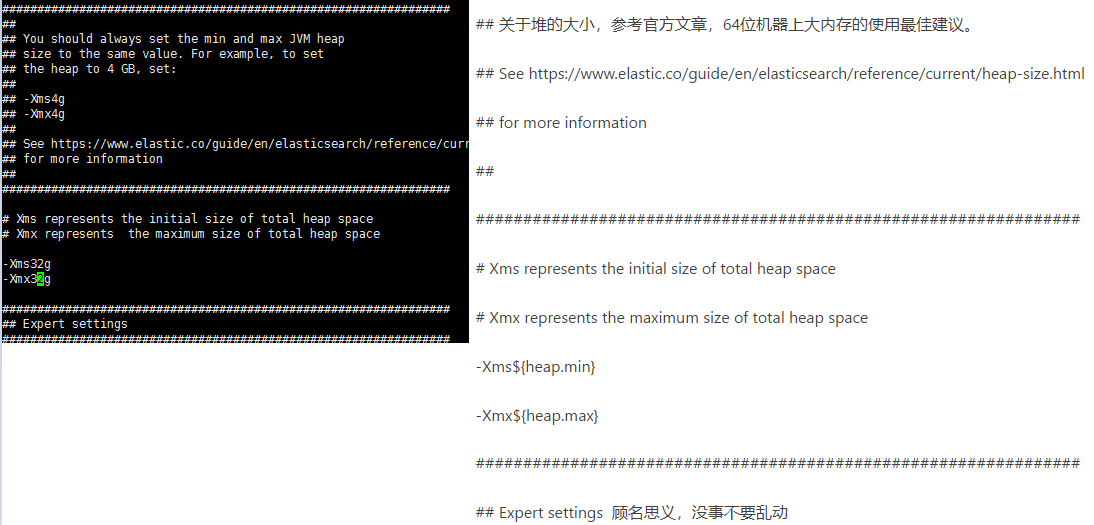
ES集群数据的迁移
快照方式
必须先停止es服务.迁移速度快,适用数据量大的场景
1.先配置源es集群的快照目录。重新启动es服务
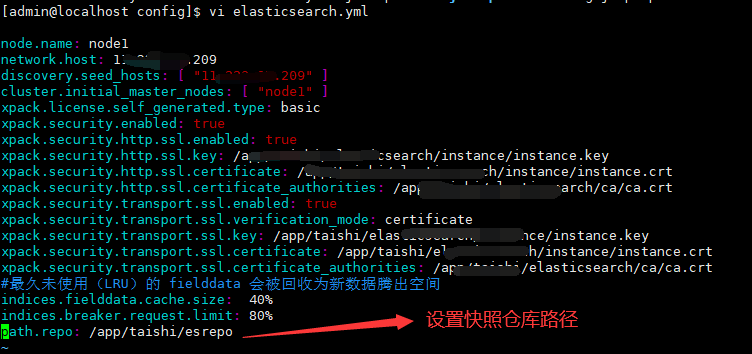
2.注册repo

curl -k -XPUT -u elastic:bbbb'https://11.223.35.209:9200/_snapshot/my_backup' -H 'Content-Type: application/json' -d '{ "type": "fs", "settings": { "location": "/app/taishi/esrepo", "compress": true } }'
3.创建快照文件
curl -k -XPUT -u elastic:bbb 'https://11.223.35.209:9200/_snapshot/my_repo/snapshot_1?wait_for_completion=true'
my_repo是第二步骤注册到es中的repo名称
snapshot_1是自定义取的快照文件名称
还原快照的时候需要根据这两个名称来恢复索引数据

4.查看快照的进度
curl -k -XGET -u elastic:bbb 'https://11.223.35.209:9200/_snapshot/my_repo/snapshot_1'



snapshot 适用于数据量大的场景 snapshot api是Elasticsearch用于对数据进行备份和恢复的一组api接口,能够经过snapshot api进行跨集群的数据迁移,原理就是从源ES集群建立数据快照,而后在目标ES集群中进行恢复。须要注意ES的版本问题: 目标ES集群的主版本号(如5.6.4中的5为主版本号)要大于等于源ES集群的主版本号; 1.x版本的集群建立的快照不能在5.x版本中恢复; 具体步骤以下: 一、源ES集群中建立repository 建立快照前必须先建立repository仓库,一个repository仓库能够包含多份快照文件,二、二、二、repository主要有一下几种类型 fs: 共享文件系统,将快照文件存放于文件系统中 url: 指定文件系统的URL路径,支持协议:http,https,ftp,file,jar s3: AWS S3对象存储,快照存放于S3中,以插件形式支持 hdfs: 快照存放于hdfs中,以插件形式支持 cos: 快照存放于腾讯云COS对象存储中,以插件形式支持 若是须要从自建ES集群迁移至腾讯云的ES集群,能够直接使用fs类型仓库,注意须要在Elasticsearch配置文件elasticsearch.yml设置仓库路径: path.repo: ["/data/es/backup"] 一、配置文件 vim elasticsearch.yml path.repo: ["/data/es/backup"] 二、注册快照仓库repository到ES中 PUT /_snapshot/es_backup { "type": "fs", "settings": { "location": "/data/es/backup/" } } 三、建立索引并添加文档 DELETE test PUT test/_doc/1 { "key": "value1", "name": "lqbyz", "age":30 } 四、建立快照 #建立全部索引的快照 PUT _snapshot/es_backup/snapshot4?wait_for_completion=true #建立指定索引建立快照 PUT /_snapshot/es_backup/snapshot_3?wait_for_completion=true { "indices": "test", "ignore_unavailable": true, "include_global_state": false, "metadata": { "taken_by": "lqbyz", "taken_because": "backup before delete" } } 五、查看相关的快照 GET _snapshot/es_backup/_all GET _snapshot/es_backup/ GET _cat/indices 六、删除相关的快照 DELETE _snapshot/my_backup GET test/_search 七、恢复快照 POST _snapshot/es_backup/snapshot_3/_restore {} #指定索引进行restore POST /_snapshot/es_backup/snapshot1/_restore { "indices": "elk-info-test-2020-06-26", "index_settings": { "index.number_of_replicas": 1 }, "ignore_index_settings": [ "index.refresh_interval" ] } 八、删除索引和快照 DELETE test DELETE _snapshot/my_fs_backup #####相关操做的查询 #####删除es_backup仓库 DELETE _snapshot/es_backup ###查看仓库信息 GET _snapshot/_all ####查看快照的 GET _snapshot/snapshot4/_status ###建立一个snapshot快照(包含全部的索引) PUT _snapshot/es_backup/snapshot4?wait_for_completion=true ###建立一个快照只包含test2的索引 PUT _snapshot/es_backup/snapshot2 { "indices": "test2" } ###查看刚才建立的快照信息 GET /_snapshot/es_backup/snapshot2 ###查看全部的快照信息 GET _snapshot/es_backup/_all ###删除一个快照 DELETE /_snapshot/es_backup/snapshot2 ###删除一个仓库 DELETE /_snapshot/es_backup 若是要中止一个正在运行的snapshot任务(备份和恢复),将其删除便可。
logstash迁移
无需停止es服务.适合迁移少量的数据
elasticsearch配置文件

discovery.seed_hosts: ["11.223.35.210", "11.223.35.211", "11.223.35.212"] # # Bootstrap the cluster using an initial set of master-eligible nodes: # cluster.initial_master_nodes: ["node-210"] # # For more information, consult the discovery and cluster formation module documentation. # # ---------------------------------- Gateway ----------------------------------- # # Block initial recovery after a full cluster restart until N nodes are started: # #gateway.recover_after_nodes: 3 # # For more information, consult the gateway module documentation. # # ---------------------------------- Various ----------------------------------- # # Require explicit names when deleting indices: # #action.destructive_requires_name: true xpack.security.enabled: false xpack.security.http.ssl.enabled: false xpack.security.transport.ssl.enabled: false xpack.license.self_generated.type: basic xpack.security.http.ssl.key: /u01/app/taishi/elastic/elasticsearch-7.8.1/config/certs/instance/instance.key xpack.security.http.ssl.certificate: /u01/app/taishi/elastic/elasticsearch-7.8.1/config/certs/instance/instance.crt xpack.security.http.ssl.certificate_authorities: /u01/app/taishi/elastic/elasticsearch-7.8.1/config/certs/ca/ca.crt xpack.security.transport.ssl.verification_mode: certificate xpack.security.transport.ssl.key: /u01/app/taishi/elastic/elasticsearch-7.8.1/config/certs/instance/instance.key xpack.security.transport.ssl.certificate: /u01/app/taishi/elastic/elasticsearch-7.8.1/config/certs/instance/instance.crt xpack.security.transport.ssl.certificate_authorities: /u01/app/taishi/elastic/elasticsearch-7.8.1/config/certs/ca/ca.crt

node.name: node1 network.host: 11.223.35.209 discovery.seed_hosts: [ "11.223.35.209" ] cluster.initial_master_nodes: [ "node1" ] xpack.license.self_generated.type: basic xpack.security.enabled: false xpack.security.http.ssl.enabled: false xpack.security.http.ssl.key: /app/taishi/elasticsearch/instance/instance.key xpack.security.http.ssl.certificate: /app/taishi/elasticsearch/instance/instance.crt xpack.security.http.ssl.certificate_authorities: /app/taishi/elasticsearch/ca/ca.crt xpack.security.transport.ssl.enabled: false xpack.security.transport.ssl.verification_mode: certificate xpack.security.transport.ssl.key: /app/taishi/elasticsearch/instance/instance.key xpack.security.transport.ssl.certificate: /app/taishi/elasticsearch/instance/instance.crt xpack.security.transport.ssl.certificate_authorities: /app/taishi/elasticsearch/ca/ca.crt #最久未使用(LRU)的 fielddata 会被回收为新数据腾出空间 indices.fielddata.cache.size: 40% indices.breaker.request.limit: 80% path.repo: /app/taishi/esrepo
logstash配置文件

input { elasticsearch { hosts => ["http://11.223.35.209:9200"] user => "elastic" index => "*,-.monitoring*,-.security*,-.kibana*" password => "5555" docinfo => true } } filter { } output { elasticsearch { hosts => ["http://11.223.35.210:9200"] user => "elastic" password => "5555" index => "%{[@metadata][_index]}" document_type => "%{[@metadata][_type]}" document_id => "%{[@metadata][_id]}" } }
启动logstash
logstash -f /home/admin/ogstash-7.6.0/config/esbackup.conf

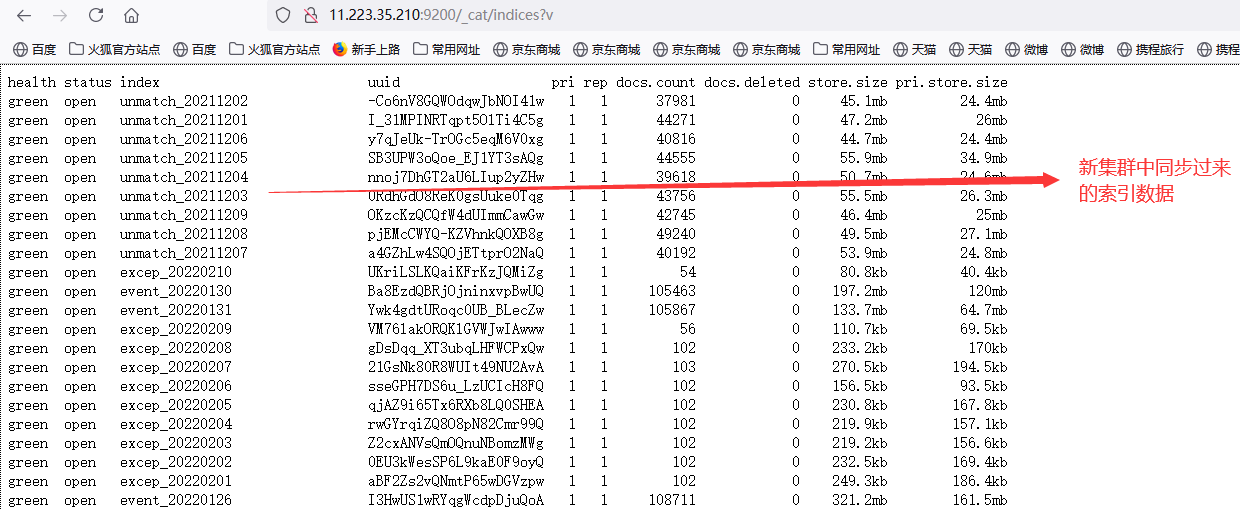
logstash连接https协议的es集群

input { elasticsearch { hosts => ["http://11.223.35.209:9200"] user => "elastic" index => "*,-.monitoring*,-.security*,-.kibana*" password => "bbbbb" docinfo => true ssl => true ssl_certificate_authorities => ["/etc/logstash/new_certs/ca.crt"] ssl_certificate => "/etc/logstash/new_certs/logstash.crt" ssl_key => "/etc/logstash/new_certs/logstash.pkcs8.key" } } filter { } output { elasticsearch { hosts => ["http://11.223.35.210:9200"] user => "elastic" password => "bbb" index => "%{[@metadata][_index]}" document_type => "%{[@metadata][_type]}" document_id => "%{[@metadata][_id]}" ssl => true ssl_certificate_authorities => ["/etc/logstash/new_certs/ca.crt"] ssl_certificate => "/etc/logstash/new_certs/logstash.crt" ssl_key => "/etc/logstash/new_certs/logstash.pkcs8.key } }
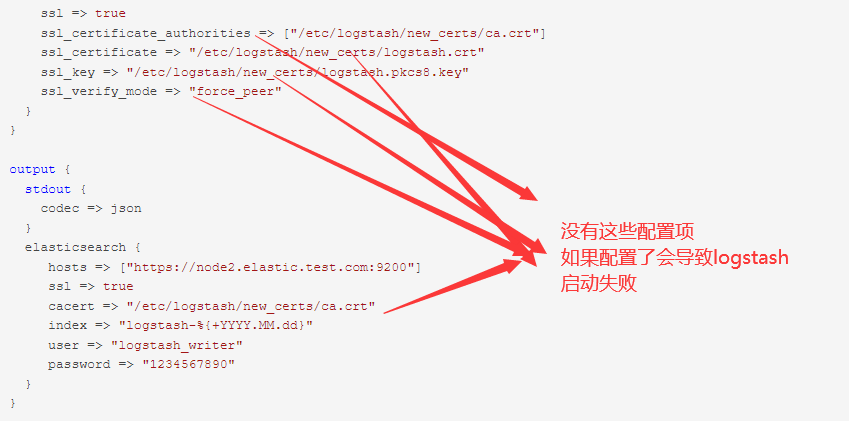

正确配置实例


input { elasticsearch { hosts => ["https://11.223.35.209:9200"] user => "elastic" index => "*,-.monitoring*,-.security*,-.kibana*" password => "6666" docinfo => true ssl => true ca_file => "/app/taishi/elasticsearch/ca/ca.crt" } } filter { } output { elasticsearch { hosts => ["http://11.223.35.210:9200"] user => "elastic" password => "666666" index => "%{[@metadata][_index]}" ssl => true ca_file => "/app/taishi/elasticsearch/ca2/ca.crt" document_type => "%{[@metadata][_type]}" document_id => "%{[@metadata][_id]}" } }


# vi test.conf input { elasticsearch { hosts => ["192.168.2.191:9200"] user => "elastic" index => "*,-.monitoring*,-.security*,-.kibana*" password => "bbb" docinfo => true ssl => true ca_file => "/app/taishi/elasticsearch/ca/ca.crt" } } filter { } output { stdout { codec => rubydebug } }

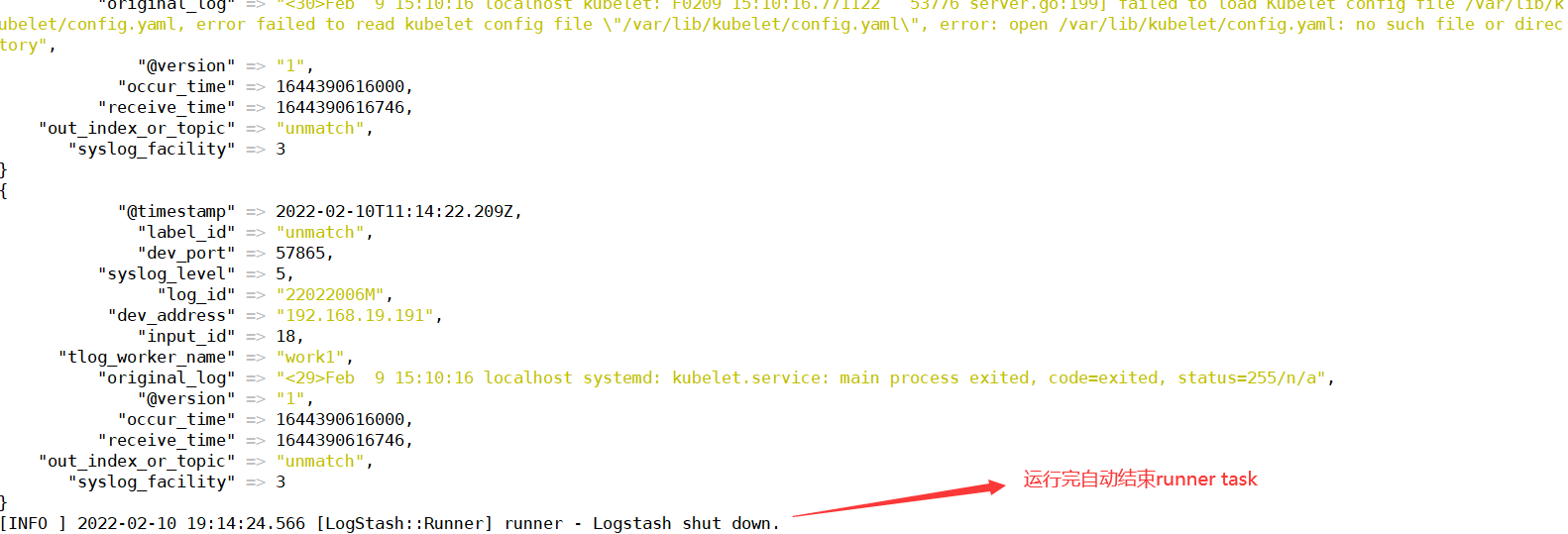

正确配置https input到https output
logstash 的input https和output https的配置语法不同
配置文件格式不能进行任何修改

input{ elasticsearch{ # 源端ES地址。 hosts => ["10.246.131.68:9200"] # 安全集群配置登录用户名密码。 user => "elastic" password => "123456" # 需要迁移的索引列表,多个索引以英文以逗号(,)分隔。 index => "prob_assets_202401" # 以下三项保持默认即可,包含线程数和迁移数据大小和Logstash JVM配置相关。 docinfo=>true slices => 5 size => 5000 ssl => true ca_file => "/home/secure/canew.crt" } } filter { # 去掉一些Logstash自己加的字段。 mutate { remove_field => ["@timestamp", "@version"] } } output{ elasticsearch{ # 目标端ES地址,可在阿里云Elasticsearch实例的基本信息页面获取。 hosts => ["https://10.30.90.147:9200"] # 安全集群配置登录用户名密码。 user => "elastic" password => "12456" # 目标端索引名称,以下配置表示索引与源端保持一致。 index => "%{[@metadata][_index]}" # 目标端索引type,以下配置表示索引类型与源端保持一致。 document_type => "%{[@metadata][_type]}" # 目标端数据的id,如果不需要保留原id,可以删除以下这行,删除后性能会更好。 # document_id => "%{[@metadata][_id]}" ilm_enabled => false manage_template => false ssl => true cacert => "/home/secure/ca.crt" } } #配置文件格式不能进行任何修改

成功执行完task
elasticsearch证书过期配置
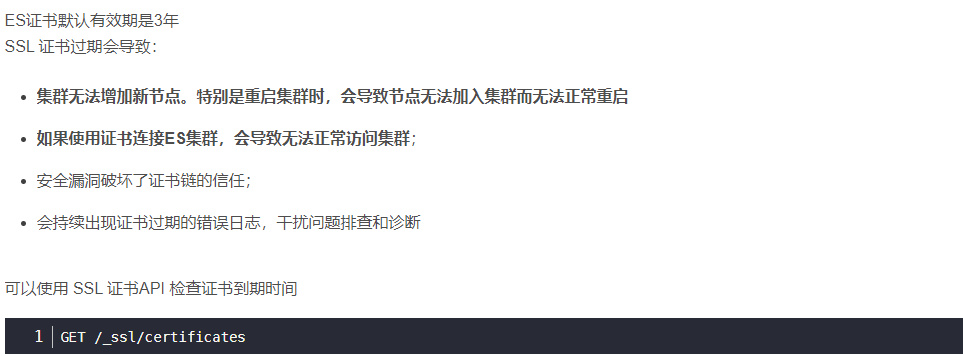
/home/taishi/elastic/elasticsearch-7.8.1/bin/elasticsearch-certutil cert --ip 192.168.100.21 --pem --days 36500 --days 表示证书的过期时间
openssl x509 -in ca/ca.crt -noout -dates

重启es集群的所有节点和相关调用es的服务即可
本文来自博客园,作者:不懂123,转载请注明原文链接:https://www.cnblogs.com/yxh168/p/15851877.html






【推荐】国内首个AI IDE,深度理解中文开发场景,立即下载体验Trae
【推荐】编程新体验,更懂你的AI,立即体验豆包MarsCode编程助手
【推荐】抖音旗下AI助手豆包,你的智能百科全书,全免费不限次数
【推荐】轻量又高性能的 SSH 工具 IShell:AI 加持,快人一步
· TypeScript + Deepseek 打造卜卦网站:技术与玄学的结合
· 阿里巴巴 QwQ-32B真的超越了 DeepSeek R-1吗?
· 【译】Visual Studio 中新的强大生产力特性
· 10年+ .NET Coder 心语 ── 封装的思维:从隐藏、稳定开始理解其本质意义
· 【设计模式】告别冗长if-else语句:使用策略模式优化代码结构